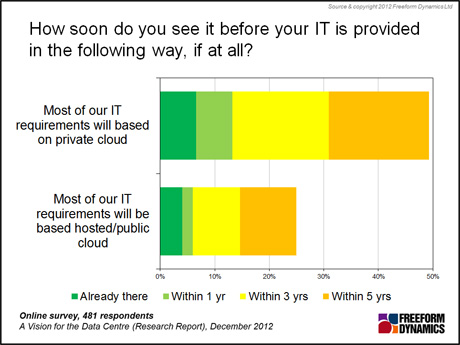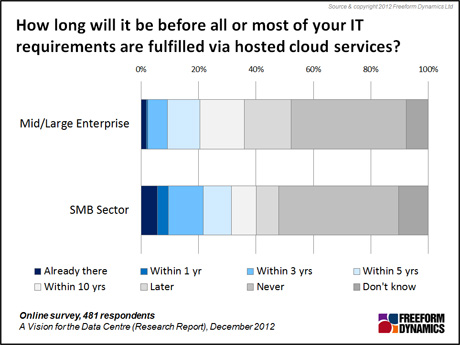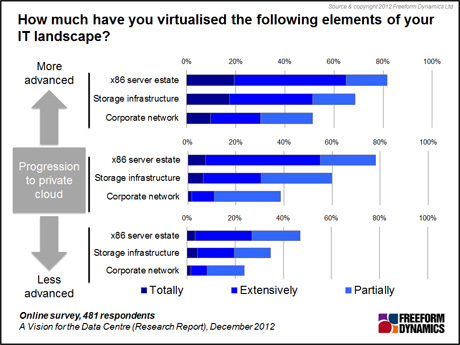By Team Freeform
It seems that every week yet another visionary or IT vendor with an agenda to set claims yet again that there is no sense to run IT internally anymore. They claim that it costs too much, is inefficient, takes too long to get things done and that just moving stuff into public cloud that things will magically be solved.
We all know instinctively that much of this is rhetoric quite far removed from mainstream reality, aimed at polarising opinion and gradually changing attitudes. However, it helps to understand more clearly just where things stand on IT service delivery and datacentre evolution in order to decide where to focus investment and business development in the coming years.
We recently ran a survey looking at how senior IT managers and architects view where IT is going, and their attitudes to and use of IT. The report is available on our website if you’d like to delve into it in more detail
At a high level we were interested in finding out what the appetite is for organisations moving most of their IT from the internal datacentre or colocation facility and out to a third party hosting or public cloud provider. It was no surprise that only around a quarter of respondents see themselves as doing this within 5 years.

For the majority, the strategy is to keep running their own IT infrastructure, with a serious intent to get this into shape through the adoption of private cloud.
Drilling a little bit deeper, another trend became apparent. A lot of the activity around relying on hosted or public cloud services to deliver the majority of IT is coming from SMBs that are often starting small and from a situation where there is little to no legacy to maintain.

Now this is not saying that hosted or public cloud services are not relevant to larger companies – just that overall public cloud will be complementary to on-premises IT rather than replacing it. If anything, the interest in hybrid cloud services – where workloads can run internally and externally – is starting to gain attention, making public cloud more relevant than ever before.
These results have a number of implications. While the majority of the SMB market don’t have any firm plans to base their IT mainly on public cloud services, there is a minority that is already doing so or have firm plans to do so. The result that buying behaviour here is likely to change significantly from kit to service subscriptions.
The good news here is that this group of customers still like to buy from local partners. Just as the existing SMB customers of large vendors such as Dell, HP, Microsoft, Symantec, Cisco and others buy physical kit mainly through reseller partners and integrators, we are also seeing the same preference when it comes to sourcing public cloud services.
The upshot of this is that providers of public cloud services will need a channel to sell effectively into the SMB markets, and the providers that will be most successful will be the ones that can do this across physical kit to cloud services in a consistent way.
For the larger customers focused on optimising their internal IT, much of the focus is going to be on adopting private cloud concepts in the coming years. For many, this will be a journey over multiple years as it is hard to get the investment to modernise the entire infrastructure in one big ‘forklift upgrade’.
A key element of private cloud adoption is the orchestration, automation and management piece. This can be achieved by running workloads on and managing physical kit directly without using virtualisation, but often this inhibits the overall capability and agility of the solution. Server virtualisation is now fairly commonplace, so what we tend to see is that as companies become more advanced in their journey to private cloud, they move beyond this, tackling initially storage and then networking virtualisation.

The next step is tying them together more tightly so that they can be managed as a whole. This is a good opportunity for upsell and consulting services as most companies have a very fragmented approach to buying and managing the different parts of their infrastructure stack, which has big implications for how agile IT can be in supporting the business in new initiatives.
To be best placed to take advantage of the coming wave of private cloud adoption will mean diversifying beyond an individual focus on networking, storage or servers to focus on the entire stack with orchestration and management at the heart.
CLICK HERE TO VIEW ORIGINAL PUBLISHED ON

Registration required